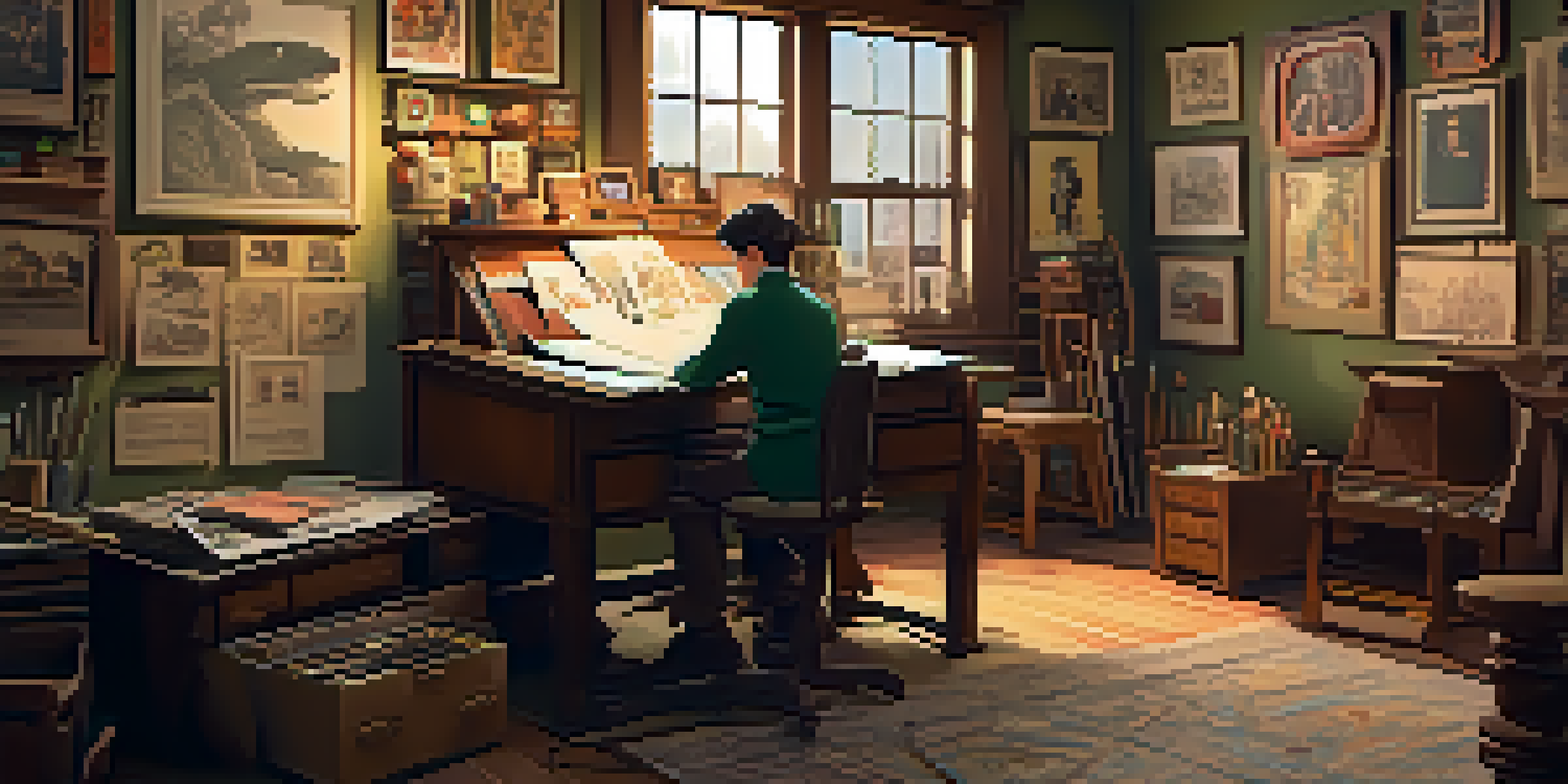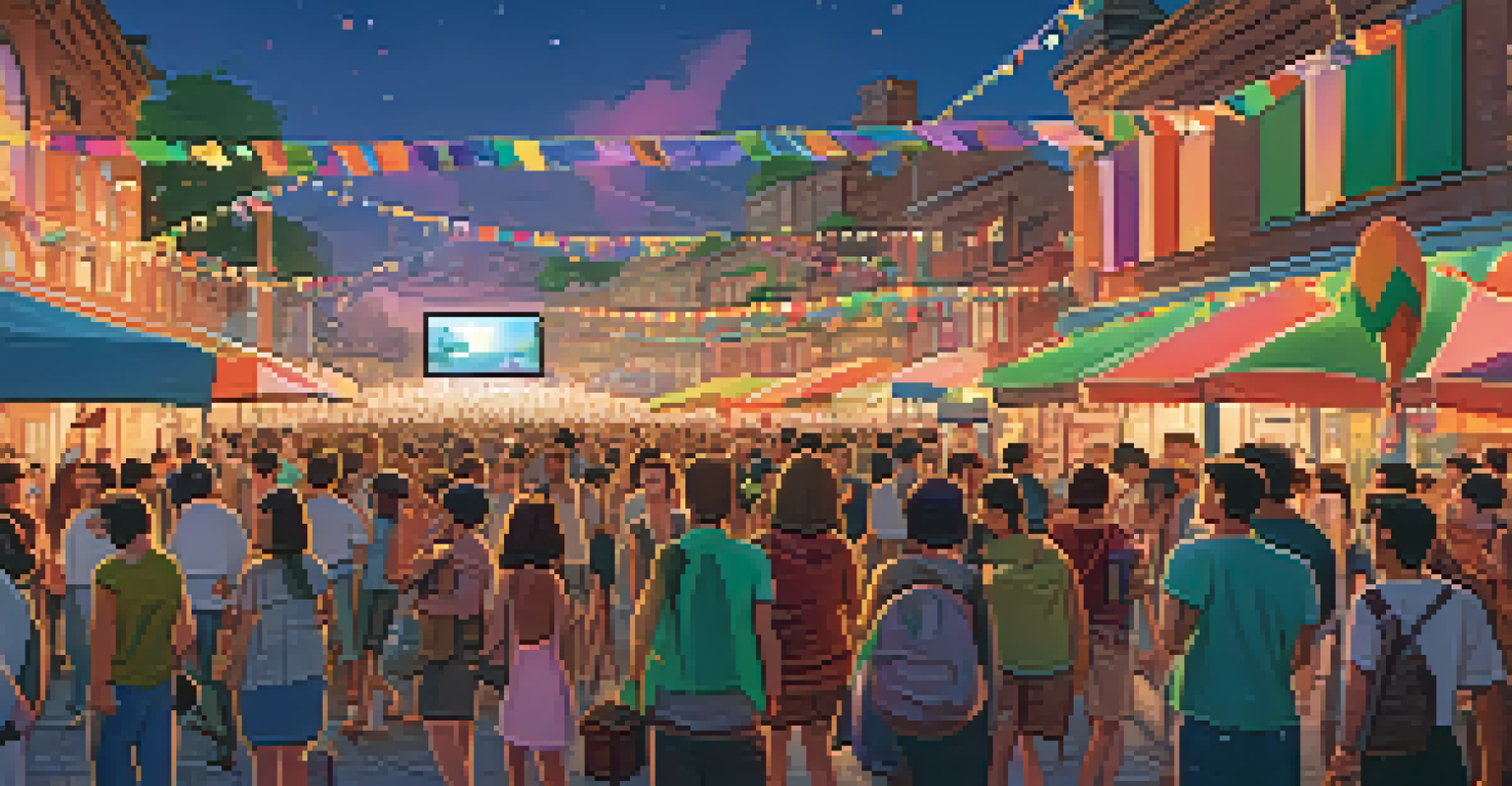The Rise of 2D Animation: From Hand-Drawn to Digital

The Origins of 2D Animation: A Hand-Drawn Legacy
2D animation has a rich history that dates back to the late 19th century, where artists used hand-drawn frames to create moving images. Early pioneers like Émile Cohl and Winsor McCay laid the groundwork with their innovative techniques, captivating audiences with the magic of motion. These early animations were labor-intensive, requiring countless drawings to produce just a few minutes of footage.
Animation can explain whatever the mind of man can conceive.
Through the decades, 2D animation evolved, and studios like Disney popularized the art form with iconic films such as 'Snow White and the Seven Dwarfs.' This marked a significant transition, as animators began to explore storytelling through character animation and vibrant worlds. The blend of creativity and technical skill captivated audiences, setting the stage for the future of animation.
As the hand-drawn style flourished, it also faced challenges, including the demand for faster production times and the need to keep up with emerging technologies. Yet, the dedication of animators to their craft ensured that the essence of hand-drawn animation remained alive, influencing new generations of creatives who would shape the industry's future.
Technological Advancements: The Shift to Digital
The introduction of digital technology in the late 20th century revolutionized the world of 2D animation. With tools like Adobe Flash and later, software like Toon Boom, animators could streamline their workflows, creating animations faster and more efficiently. This shift not only increased productivity but also opened new avenues for creativity, allowing for more complex and polished visuals.

Digital animation also democratized the art form, making it accessible to aspiring animators. With the rise of the internet, talented individuals could showcase their work on platforms like YouTube, reaching audiences without the need for traditional gatekeepers. This shift led to a surge of independent animators who brought fresh perspectives and innovative ideas to the industry.
2D Animation's Rich History
2D animation has evolved from labor-intensive, hand-drawn techniques to a vibrant medium that captivates audiences across generations.
As digital techniques continued to evolve, they incorporated elements of traditional animation, blending the best of both worlds. This fusion resulted in a vibrant new style that resonates with audiences, proving that while technology can enhance creativity, the core principles of storytelling and artistry remain essential.
The Impact of 2D Animation on Pop Culture
2D animation has significantly influenced pop culture, shaping how stories are told across various media. Iconic characters like Mickey Mouse and Bugs Bunny have become cultural symbols, representing not just animation but also broader themes of creativity and imagination. These characters have transcended generations, showcasing the lasting impact of 2D animation on society.
The art of animation is the art of storytelling through movement.
In recent years, series like 'Adventure Time' and 'Rick and Morty' have demonstrated that 2D animation can tackle complex themes and resonate with adult audiences. This expansion of the medium's reach has encouraged more diverse storytelling, allowing for unique narratives that reflect contemporary issues. The versatility of 2D animation continues to challenge traditional norms, drawing in viewers of all ages.
Moreover, the collaboration between animation and other art forms, such as video games and web series, has further solidified 2D animation's place in pop culture. The fusion of these mediums creates dynamic experiences that engage audiences in new ways, proving that the possibilities for 2D animation are limitless.
The Role of 2D Animation in Education and Communication
2D animation has found a valuable niche in education, where it serves as an effective tool for teaching complex concepts. Animated videos can simplify intricate subjects, making them more digestible for learners of all ages. Educational institutions and organizations are increasingly utilizing animated content to enhance their teaching methods and engage students.
In addition to education, 2D animation is also a powerful medium for communication. Businesses and non-profits use animated explainer videos to convey their messages in a clear and engaging manner. This approach not only captures attention but also aids in retaining information, making it a preferred choice for marketing and outreach efforts.
Digital Tools Transform Animation
The advent of digital technology has streamlined animation processes, making the art form more accessible and allowing for innovative storytelling.
The effectiveness of 2D animation in these contexts highlights its ability to bridge gaps in understanding. By combining visuals with storytelling, animators can create compelling narratives that resonate with audiences. This versatility reinforces the notion that 2D animation is not just entertainment but a valuable asset in various fields.
The Revival of Hand-Drawn Techniques in Modern Animation
Despite the rise of digital animation, there has been a notable revival of hand-drawn techniques in recent years. Filmmakers and animators are returning to traditional methods, inspired by the nostalgia and craftsmanship associated with hand-drawn art. Movies like 'The Princess and the Frog' and 'Wolfwalkers' showcase the beauty and depth that hand-drawn animation can achieve, reminding audiences of its unique charm.
This resurgence reflects a broader appreciation for the artistry involved in hand-drawn animation. Many animators are blending digital tools with traditional techniques, creating hybrid styles that celebrate both worlds. This fusion allows for innovative storytelling while preserving the tactile quality of hand-drawn animation.
The revival isn't just about aesthetics; it also connects with audiences on an emotional level. Many viewers find comfort in the familiar styles that remind them of their childhoods. This emotional resonance not only brings in nostalgic audiences but also introduces younger generations to the beauty of hand-drawn animation.
The Future of 2D Animation: Trends and Innovations
As technology continues to advance, the future of 2D animation looks promising. New tools and software are emerging, offering animators even more opportunities to push creative boundaries. Innovations like augmented reality (AR) and virtual reality (VR) are beginning to influence how 2D animations are created and experienced, providing immersive storytelling possibilities.
Additionally, the rise of artificial intelligence is changing the landscape of animation production. AI can assist in creating animations, allowing artists to focus on the creative aspects rather than the technical details. This shift may lead to faster production times and more diverse animated content, as creators are empowered to explore new ideas.
Community Drives 2D Animation Growth
The thriving community of animators and enthusiasts fosters creativity and collaboration, ensuring the continued evolution and celebration of 2D animation.
Despite these advancements, the core principles of 2D animation—storytelling and artistry—will remain central to its evolution. As animators continue to experiment with technology, the essence of what makes 2D animation compelling will endure, ensuring its relevance in an ever-changing digital landscape.
Celebrating 2D Animation: A Community of Creatives
The world of 2D animation is not just about the finished product; it's also about the vibrant community of artists and enthusiasts who share a passion for the craft. From online forums to social media platforms, animators connect, collaborate, and inspire one another, fostering a culture of creativity and innovation. This sense of community plays a crucial role in the growth and evolution of 2D animation.
Events like animation festivals and conventions celebrate the artistry and achievements within the field. These gatherings provide animators with opportunities to showcase their work, network with industry professionals, and gain insights into the latest trends. Such events not only highlight individual talents but also emphasize the collective spirit of the animation community.

Ultimately, the celebration of 2D animation extends beyond the screen—it reflects a shared love for storytelling through art. As animators continue to push boundaries and explore new horizons, the legacy of 2D animation will undoubtedly thrive, inspiring future generations to embark on their own creative journeys.